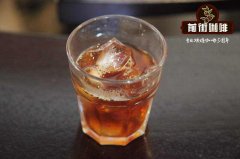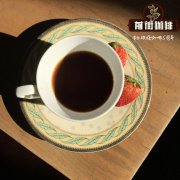What are the flavor and taste characteristics of sun-dried beans [Black Soul] in La Jas Manor, Costa Rica? How to hand

Professional coffee knowledge exchange more coffee bean information please follow the coffee workshop (Wechat official account cafe_style)
What are the flavor and taste characteristics of sun-dried beans [Black Soul] in La Jas Manor, Costa Rica? How to make Costa Rican coffee by hand?
Located in the central valley at the foot of the Po á s de Alajuela volcano, Lajas Manor has been operated by the owner Chac ó n family for more than 80 years. It is 1300m above sea level and has an annual output of about 46000 jin. During the annual production season of La Lajas Manor from December to February, the owner insists on harvesting only ripe and red fruits, and most of them use dense treatment and sun drying to enhance the sweetness and mellowness of the coffee, and at the same time, it is placed in the African shelf-type sunburn field to ensure that the coffee can evenly receive the sun and avoid excessive fermentation. At the same time, the manor has also actively obtained international organic certification, which has been certified by USDA of the United States, JAS of Japan and NOP of Japan.
Coffee began to appear in Costa Rica in 1729, when it was introduced from Cuba. This made Costa Rica the first country in Central America to grow coffee and the first to grow coffee because of its commercial value. Then, after Costa Rica became independent from Spain in 1821, the local government began to support the coffee industry with a series of policies. At that time, it was more than a hundred years after coffee was introduced into Costa Rica, but about 70,000 coffee trees have been planted, which shows the speed of its development. The local government's policies on the coffee industry include:
It is conceivable that when there are more products, the quality will become different, affecting competitiveness. So in order to improve the quality and value of coffee, at the beginning of the 20th century, the government enacted legislation that coffee farms or plantations in Costa Rica could only grow coffee from Arabica, so as to enhance their competitiveness. This helps to understand why Costa Rican coffee is now so superior: coffee from Costa Rica is all Arabica, and we can never find Robusta.
Subsequently, in 1948, the Costa Rican government established an exclusive coffee department (that is, the Costa Rican coffee industry company ICAFE:Institutodel Caf é de Costa Rica. It has been taken over by the official Coffee Committee Oficinadel Caf é), mainly coaching the manor from planting, post-processing to the improvement of the sales system. The place is also very careful in handling coffee for export. Among the exported coffee, coffee beans that are considered to be of substandard quality will be colored by blue plant dyes and then returned to China for sale. Today, about 1/3 of Costa Rica's population is engaged in coffee or coffee-related industries, and per capita coffee consumption is twice that of Italy or the United States. From various policies, we can see that the government's support for the coffee industry has indirectly made Costa Rica's coffee better and more competitive than other countries.
In 1825, the Costa Rican government implemented a tax exemption policy. In 1832, the local government promulgated a law that "there is land for growing coffee", meaning that coffee farmers can own the land directly if they grow coffee on any land that is not occupied. As soon as this example comes out, it encourages many people to grow coffee and promote the development of coffee. (it can also indirectly explain why most of Costa Rican coffee comes from private estates.)
Producing area: central valley
Grade: SHB
Treatment: insolation
Altitude: 1300 Murray 1500m
Variety: Kaddura, Kaduai
Flavor description: passion fruit, drupe, black jujube, blueberry.
Qianjie recommended cooking method: hand flushing
V60 filter cup, 15g powder, water temperature 89 degrees, small Fuji grinding degree 4, water powder ratio close to 1:15.
30 grams of water steaming, steaming time for 30 seconds, subsection: injection to 130 grams of water cut off, such as the water level dropped by 1 stroke 3, again water injection to 225 grams.
Important Notice :
前街咖啡 FrontStreet Coffee has moved to new addredd:
FrontStreet Coffee Address: 315,Donghua East Road,GuangZhou
Tel:020 38364473
- Prev

What is the geographical location of coffee cultivation in Kenya? Water from the Kirinyaga treatment plant in Kangunu, Kenya
Professional coffee knowledge exchange more coffee bean information please follow the coffee workshop (Wechat official account cafe_style) where is the location of coffee cultivation in Kenya? Description of the flavor of washed AA coffee from the Kangunu Kirinyaga treatment plant in Kenya? The producing area of Kirinyaga, Kangunu, comes from Embu, a community south of Nairobi, at an altitude of 1600-1700. According to the cup survey of the bean merchant
- Next

The flavor of honey-treated beans in Alajuela, Althacia, Costa Rica. Brother
Professional coffee knowledge exchange more coffee bean information please follow the coffee workshop (Wechat official account cafe_style) [adobe farmers] in Alajuela, Althacia, Costa Rica.
Related
- Detailed explanation of Jadeite planting Land in Panamanian Jadeite Manor introduction to the grading system of Jadeite competitive bidding, Red bid, Green bid and Rose Summer
- Story of Coffee planting in Brenka region of Costa Rica Stonehenge Manor anaerobic heavy honey treatment of flavor mouth
- What's on the barrel of Blue Mountain Coffee beans?
- Can American coffee also pull flowers? How to use hot American style to pull out a good-looking pattern?
- Can you make a cold extract with coffee beans? What is the right proportion for cold-extracted coffee formula?
- Indonesian PWN Gold Mandrine Coffee Origin Features Flavor How to Chong? Mandolin coffee is American.
- A brief introduction to the flavor characteristics of Brazilian yellow bourbon coffee beans
- What is the effect of different water quality on the flavor of cold-extracted coffee? What kind of water is best for brewing coffee?
- Why do you think of Rose Summer whenever you mention Panamanian coffee?
- Introduction to the characteristics of authentic blue mountain coffee bean producing areas? What is the CIB Coffee Authority in Jamaica?

